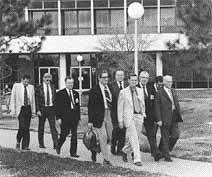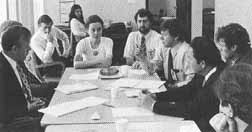
Soviet Worries About Apollo Minus
X
Thrusters
According to the Americans, there was nothing to worry about. As Apollo approached Soyuz, the attitude control motors used to brake the [275] craft would not send exhaust far enough to burn the thermal insulating blanket that protected Soyuz from the heat of the sun, nor would the Soyuz radio antennas be affected. But the Soviets were worried that the plume of the thrusters might hit their craft if the astronauts forgot to shut down those -X engines* after capture by the docking gear, As in the case of the American worries over Soyuz, the home team could not quite see what all the fuss was about. Nevertheless, they had to attend to their visitors' unease.63
Ed Smith, whose Working Group 2 had to deal with such problems, traced the origin of the Soviet interest in the possible impingement of the -X thrusters on Soyuz to a Skylab movie that Max Faget had taken to the U.S.S.R. to show at a gathering of space scientists. In this movie, the Skylab parasol fluttered in reaction to firings of the Apollo thrusters as the docking approach was executed. Subsequently, at the August-September 1974 sessions in Moscow, Vladimir Timchenko, Soviet chairman of Group 1, asked his American colleagues if these thruster firings could be expected to have any effect on Soyuz. Timchenko's concern was associated less with the possibility of damage to Soyuz than that the control system firings in the vacuum of space would upset the attitude of Soyuz and cause the ship to deviate from the reference attitude it needed to maintain during the docking maneuvers.
Richard Haken, a contract employee working with Group 2, said that he would pull together all the data JSC had concerning the expected lengths of time for -X thruster firings when Apollo was both approaching and docking with Soyuz. He gave his findings to the Soviets during the November 1974 Houston meeting, and they took them home to study. Following their analysis, they sent a specialist, B. P. Skotnikov, to Houston in December with a Working Group 1 delegation to work with Smith, Haken, Steven Pollock, and Roscoe Lee on the possibility that the Apollo control system firings could create disturbance torques that would upset Soyuz. They concluded in the negative:
At this meeting, both sides have presented and discussed the materials on the evaluation of the disturbance forces and torques, which affect the Soyuz spacecraft during operation of the Apollo RCS jets when docking. . . . As described in USA WG2-051, during normal docking, the Apollo RCS jets work in pulses. It was noted that beginning with a distance of six meters during docking, Apollo RCS jet pulses of 0.5 sec and larger are extremely rare and their repetition extremely remote. Both sides concluded that when the Apollo RCS jets work in pulses, small disturbance torques exist which do not cause deviation in the attitude of the Soyuz spacecraft.64
[276] But the Apollo thruster question did not end in November. At the January-February meetings, the Soviet delegation included A. G. Reshetin, an aerothermal expert who wanted to discuss the thermal impingement of the thruster firings on the surface of Soyuz. These talks covered the entire approach and docking sequence. From these reconsiderations of the -X thruster firings, the Americans came to understand that the basic worry the Soviets had was not how long the reaction control system (RCS) jets might be fired during approach but just what guaranteed that they would be shut off after capture by the docking system. The Americans said that one had to rely upon the crewmen to throw the switches that would inhibit further operation of the thrusters. This reliance on men bothered the Soviets, who would have preferred to have those engines controlled by an automatic system.
The "RCS impingement problem," as it became known, bounced around during the January-February discussions until it promised to become a real issue of more magnitude than seemed justified in the minds of the Americans. To the Soviets, it continued to be a worrisome topic that needed further explanation and a definitive resolution. They wanted the Americans to state in their flight plan that the Apollo crew "shall not" use the -X thrusters within 10 meters of Soyuz. Lunney had to step in and take a firm hand because the entire discussion was getting out of hand and no resolution appeared in sight.
Following a frank meeting on 30 January in which Lunney and his team discussed the meeting's progress to date, Ed Smith gave the Professor the run down on a procedure that would ensure that the -X engines would not be fired after capture was made by the docking system. As Smith explained it, when the Apollo docking system captured Soyuz, an indicator light would appear in Apollo, and the Command Module Pilot would call out "contact" to the Commander, who would cease forward translation. At that point, the Commander would switch control of the RCS engines from the stabilization and control system to a second system controlled by the command module computer in a free mode (CMC-free), which would operate only upon a manual command given through the hand controller. While the RCS system was in this dormant condition, the commander would reach up and turn off the four RCS automatic select switches that control the forward firing thrusters. Finally, the computer would take over again, correcting the pitch and yaw of the two spacecraft as needed. The entire process would take only a matter of seconds.
When Smith completed his description, there followed a 40-minute discussion, and the process was described again and again. Bushuyev had a number of questions. V. P. Legostayev explained the process in Russian to Petrov and the Professor, while sketches were passed back and forth across the table. With Yuri Zonov and Alex Tatistcheff interpreting, Lunney tried to answer the Soviets' several questions. The scene was hectic, and in the end Bushuyev still had some doubt in his mind about relying upon the crew to throw those important switches.
[277] RCS impingement problem, January 1975
|
|
Soviet concern that the Soyuz spacecraft would be endangered by the exhaust from Apollo's reaction control system (RCS) received much attention during the meetings in Houston in January-February 1975. In one of the Working Groups, flight director Alexei Yeliseyev (left) listens as Pete Frank (gesturing with pen) explains the safeguards provided in the firing sequence of the RCS. Also listening (left to right) are Gene Cernan (obscured by Yeliseyev), Yu. S. Denisov, N. Latter, R. D. White, Frank, V. P. Legostayev, V. S. Syromyatnikov, and B. V. Nikitin. |
 | |
 |
At left above with arm extended, Yuri Zonov asks Lunney a question about RCS impingement. Finally, Professor Bushuyev, still not convinced, asks to see the astronauts throw the RCS isolation switches in the command module simulator to observe how much time it takes to disarm the -X thrusters. Left, all are smiling on the way back from the simulators where Lunney, Bushuyev, and others have watched the RCS exercise perfomed to everyone's satisfaction. |
At this point, the whole "RCS impingement" issue was becoming an emotional subject. Some of the astronauts were openly upset that the [278] Soviets would question their training and discipline when it came to executing the proper sequence of actions. While Legostayev understood the Americans' explanation, Yeliseyev, the flight director, was still not convinced. According to Zonov, "Yeliseyev was the big skeptic." The issue was at last resolved on 5 February when Petrov and Yeliseyev climbed into the Apollo command module simulator and went through the procedures from the calling out of "capture" to throwing the proper switches. Once they saw how it worked, the troublesome issue seemed to go away. It also appeared that Petrov was growing tired of this recurring topic, and being personally convinced that there was no real problem he told his people to drop it. At the ASAP briefing the next morning, Bushuyev indicated that there had been some concern about the possibility of RCS impingement but that it had been the subject of enough discussion.
The RCS controversy demonstrated the different approaches to rendezvousing and docking spacecraft automatic versus pilot controlled and while it had been a real worry for many of the specialists, Lunney had not let it upset him. It was a problem for which there was a technical solution. Once his men told him how they intended to handle the matter, he explained it to the Soviets and invited them to the simulator where they could see that the proposed solution was indeed satisfactory. It was all part of a day's work, and there was no need to become emotional. On 31 January, when the issue was still pending, Lunney was asked how the meeting was going. He responded, "This . . . is a piece of cake"; he wished that he could get away from the Grumman building, where the talks were being held, and go back across NASA Road 1 to clean up the paper work on his desk. When asked about the RCS situation, he smiled with a characteristic twinkle in his eyes and said, "Nyet problem." Then he added, "If you think that is a hot issue, you should have seen some of our earlier go-arounds." Chomping down on his cigar, he went in search of a cup of coffee.65
* Minus X engines are the forward firing thrusters used to brake or slow down the Apollo spacecraft.
63. Interview, Herbert E. Smith, Richard Haken, Steven Pollock, and Roscoe Lee-Ezell, 12 Feb. 1975.
64. "Meeting Minutes, Joint Meeting of Working Group 1," 25 Nov.-20 Dec. 1974.
65. This description of
the RCS impingement meeting is based upon notes taken by Ezell during
that discussion and upon subsequent talks with Eugene A. Cernan,
Lunney, and members of Working Group 2. Yuri Zonov's comment was made
to Ezell after the trip to the simulator.
Next
